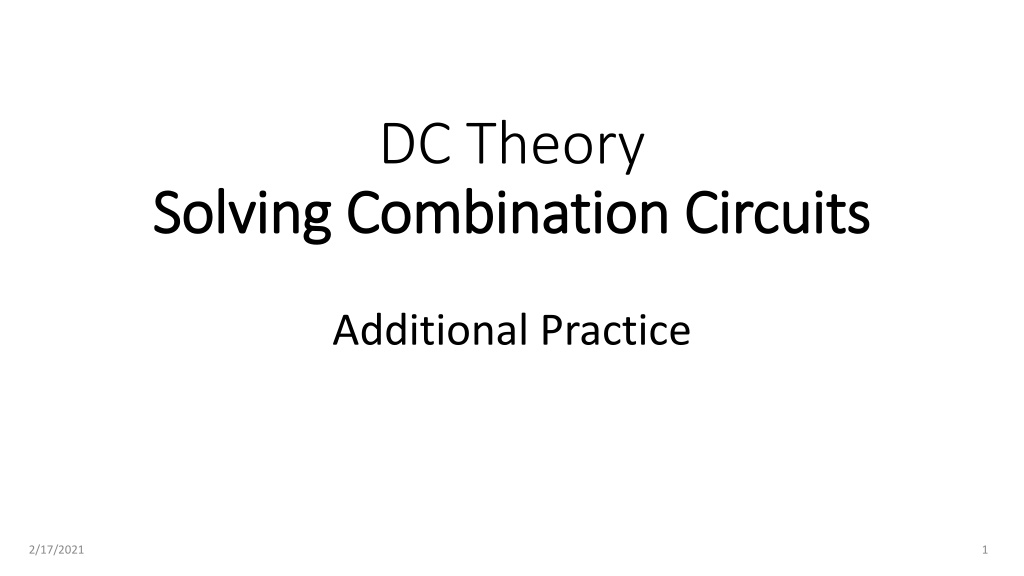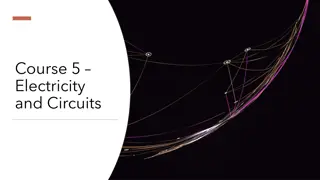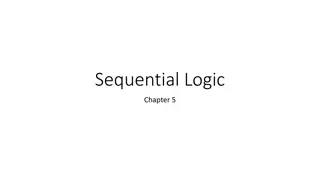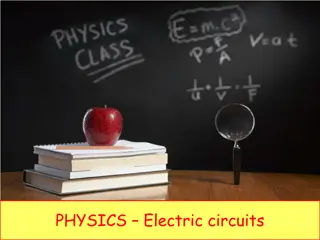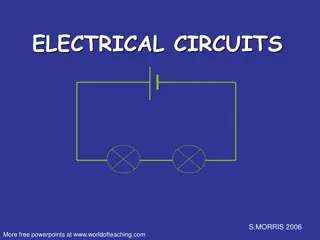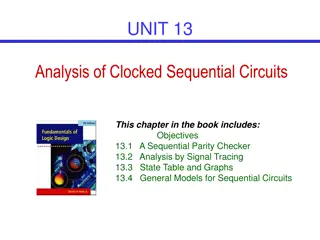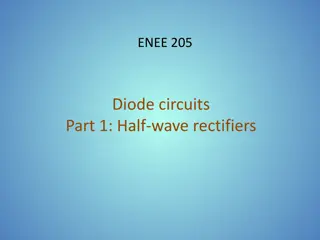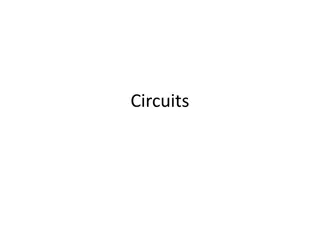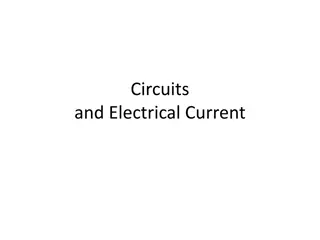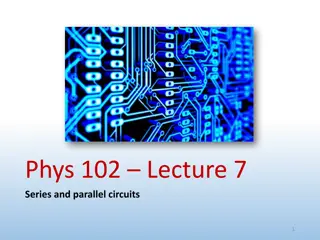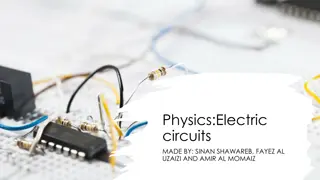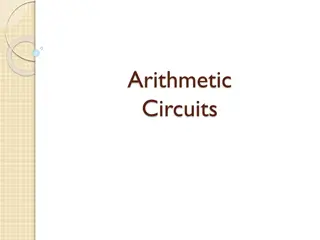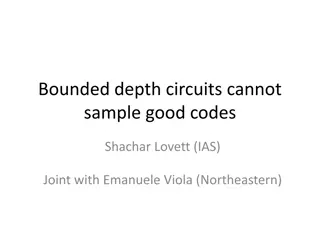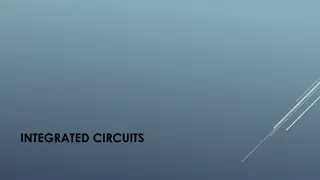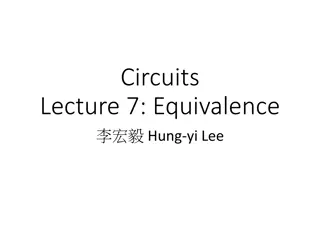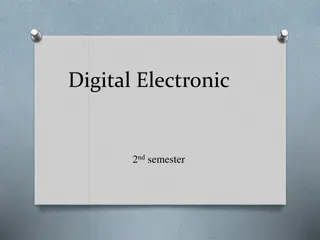Solving Combination Circuits: Practice and Problem-Solving
Explore solving combination circuits through practice exercises and class problem-solving techniques involving equivalent resistance determination, PIER chart application, Kirchhoff's laws, current and voltage analysis, and power dissipation calculations. Enhance your understanding of circuit analysis fundamentals.
Download Presentation

Please find below an Image/Link to download the presentation.
The content on the website is provided AS IS for your information and personal use only. It may not be sold, licensed, or shared on other websites without obtaining consent from the author.If you encounter any issues during the download, it is possible that the publisher has removed the file from their server.
You are allowed to download the files provided on this website for personal or commercial use, subject to the condition that they are used lawfully. All files are the property of their respective owners.
The content on the website is provided AS IS for your information and personal use only. It may not be sold, licensed, or shared on other websites without obtaining consent from the author.
E N D
Presentation Transcript
DC Theory Solving Combination Circuits Solving Combination Circuits Additional Practice 2/17/2021 1
Combination Circuits Combination Circuits Find equivalent resistance in combination circuits. Solve a combination circuit using a PIER Chart. Using Kirchhoff s Current and Voltage Laws 2/17/2021 2
Class Problem 1 Handout 2/17/2021 3
Handout 2/17/2021 4
285 16.67 Find any parallel and/or series combinations that can be reduced. 45.9 2/17/2021 5
16.67 285 79.67 45.9 50 2/17/2021 6
General Problem-Solving Process Draw circuit to provide space to mark node voltages and branch currents. Place known values in PIER Chart Source current, voltage and resistance are known, so apply KVL and KCL KVL: All voltages around any closed loop sum to zero. KCL: All currents entering or leaving a node sum to zero. 2/17/2021 7
Class Problem 2 Class Problem 2 1. Load known values in PIER Chart 2. Apply rules to find total equivalent resistance. 3. Find total current supplied. (= IR1 and IR4) 4. Find voltage drops across R1 and R4 5. Find voltage drop across // combination of R3 and R2 (KVL: Total voltage around any closed path = 0) 6. Find current in R3 and R2 7. Find the power dissipated in each load and the total power dissipated (= supplied) in the circuit. Handout E R I P E I R P E I R1 R2 R3 R4 2/17/2021 Total 8
Handout 2/17/2021 9
Class Problem 2 Class Problem 2 1. Load known values in PIER Chart 2. Apply rules to find total equivalent resistance. 3. Find total current supplied. (= IR1 and IR4) 4. Find voltage drops across R1 and R4 5. Find voltage drop across // combination of R3 and R2 (KVL: Total voltage around any closed path = 0) 6. Find current in R3 and R2 7. Find the power dissipated in each load and the total power dissipated (= supplied) in the circuit. E R I P E I E 10 12 12 8 30 V I R P 20 40 60 16 60 R1 R2 R3 R4 .5 .3 .2 .5 .5 2/17/2021 Total 10
Class Problem 2 Class Problem 2 1. Load known values in PIER Chart 2. Apply rules to find total equivalent resistance. 3. Find total current supplied. (= IR1 and IR4) 4. Find voltage drops across R1 and R4 5. Find voltage drop across // combination of R3 and R2 (KVL: Total voltage around any closed path = 0) 6. Find current in R3 and R2 7. Find the power dissipated in each load and the total power dissipated (= supplied) in the circuit. E R I P E I E I R P 20 40 60 16 60 R1 R2 R3 R4 10 V 12 V 12 V 8 V 30 V .5 A .3 A .2A .5 A .5 A 5 W 3.6 W 2.4 W 4 W 15 W 2/17/2021 Total 11
P E PIER Chart PIER Chart Combination Circuits Combination Circuits E I 10 V .5 A 12 V .3 A 12 V .2A 8 V .5 A Total 30 V .5 A E I R I R P 20 40 60 16 60 R1 R2 R3 R4 5 W 3.6 W 2.4 W 4 W 15 W P = IE for all loads (including source/ total load). E = IR for all loads. KVL: All voltages around any closed loop sum to zero. KCL: All currents entering or leaving a node sum to zero. Use series and parallel equations to find total resistance for combination circuits. Power in each load sums to total power for all circuits. 2/17/2021 12
Kirchoffs Kirchoff s Current Law Current Law The algebraic sum of all currents entering/leaving a node = 0. R1 25 R2 25 R3 5 200V 2A 100 R6 10 R4 50 R5 30 Kirchoff s Kirchoff s Voltage Law Voltage Law The algebraic sum of all voltages in a closed loop = 0. R7 50 R9 15 R8 10 2/17/2021 13
General Problem-Solving Process 1. Draw/markup circuit diagram as you work. 2. Load known values in PIER Chart. 3. Apply Series/Parallel rules to find total equivalent resistance. 4. Find total current supplied. 5. Find voltage drops across resistors and node voltages. 6. Apply KVL and KCL as needed. Combination R1 25 R2 25 - R4 30 R3 50 220 V + R5 50 R6 10 2/17/2021 14
Class Problem 3 Class Problem 3 R1 25 R2 25 R3 5 200V 2A 100 R6 10 R4 50 R5 30 R7 50 R9 15 R8 10 2/17/2021 15
PIER Chart PIER Chart E E I R P R1 R2 R3 R4 R5 R6 R7 R8 R9 25 25 5 50 30 10 50 10 15 100 50 V 25 V 2 A 1 A 0.5 A 100 W 25 W 1.25 W R I 2.5 V P 1 A 0.5 A 0.5 A 50 W 7.5 W 2.5 W 200 W 10 W 3.75 W 400 W 50 V 15 V E I 5 V 100 V 2 A 1 A 0.5 A 10 V 7.5 V 2/17/2021 Total 200 V 2 A 16
Handout Class Problem 3 Class Problem 3 R1 25 R2 25 R3 5 200V 2A 100 R6 10 R4 50 R5 30 R7 50 R9 15 R8 10 2/17/2021 17
Computations Computations 2/17/2021 18
Handout PIER Chart PIER Chart E E I R P R1 R2 R3 R4 R5 R6 R7 R8 R9 R I P E I 2/17/2021 Total 19
Series Parallel P E 220 E I R I + + 5V 470 470 220 5V - - KVL 1000 Voltage Rises = Voltage Drops (around any closed path) 1 ??= 1 ?1+1 ?2+1 ??= ?1+ ?2+ ?3+ ?3+ KCL ?? ?? ??=?1 ?2 ?1+ ?2 ??= ?? Current In = Current Out (through any node) ?? ?? ??= ?? Kilo 1000 .001 kA ?2 Base 1 1 A ?1= ?? ?1+ ?2 Milli .001 1000 mA 2/17/2021 20
Handout Practice Combination Circuit 1. Draw/markup circuit diagram as you work. Show node voltages and current directions. 2. Load known values in PIER Chart. 3. Apply Series/Parallel rules to find total equivalent resistance. 4. Find total current supplied. 5. Find voltage drops across resistors and node voltages. 6. Apply KVL and KCL as needed. R1 20 R2 25 - R4 30 R3 40 220 V + R5 30 Write equations / show work! 2/17/2021 21
Review Problem 1 Review Problem 1 R1 20 R2 25 Total equivalent resistance: - R4 50 R3 60 220 V + Total Current: R5 30 Voltage drop across R2: 2/17/2021 22
Handout PIER Chart PIER Chart E I R P R1 R2 R3 R4 R5 Total 2/17/2021 23
Handout Review Problem 2 Review Problem 2 R1 20 R4 20 R5 20 R2 40 - 220 V + R6 30 R3 30 2/17/2021 24
Handout PIER Chart PIER Chart E E I R P R I R1 R2 R3 R4 R5 R6 Total P E I 2/17/2021 25
Circuit Concepts Circuit Concepts The equivalent resistance is substituted back into a combination circuit that represents the _______________ value as all of the resistances combined. same the same as The current leaving the source is _______________ the current returning to the source in a combination, or series-parallel, circuit. Any circuit in which the current is split or follows two (or more) alternative paths is called a(n) _______________ circuit. parallel Identify the first step necessary to allow calculation of component voltages in a combination circuit with component resistors in series and parallel. Determine the total resistance. Component currents in combination circuits are generally calculated by applying _______________ to the component voltage and the component resistance. Ohm s Law 2/17/2021 26
